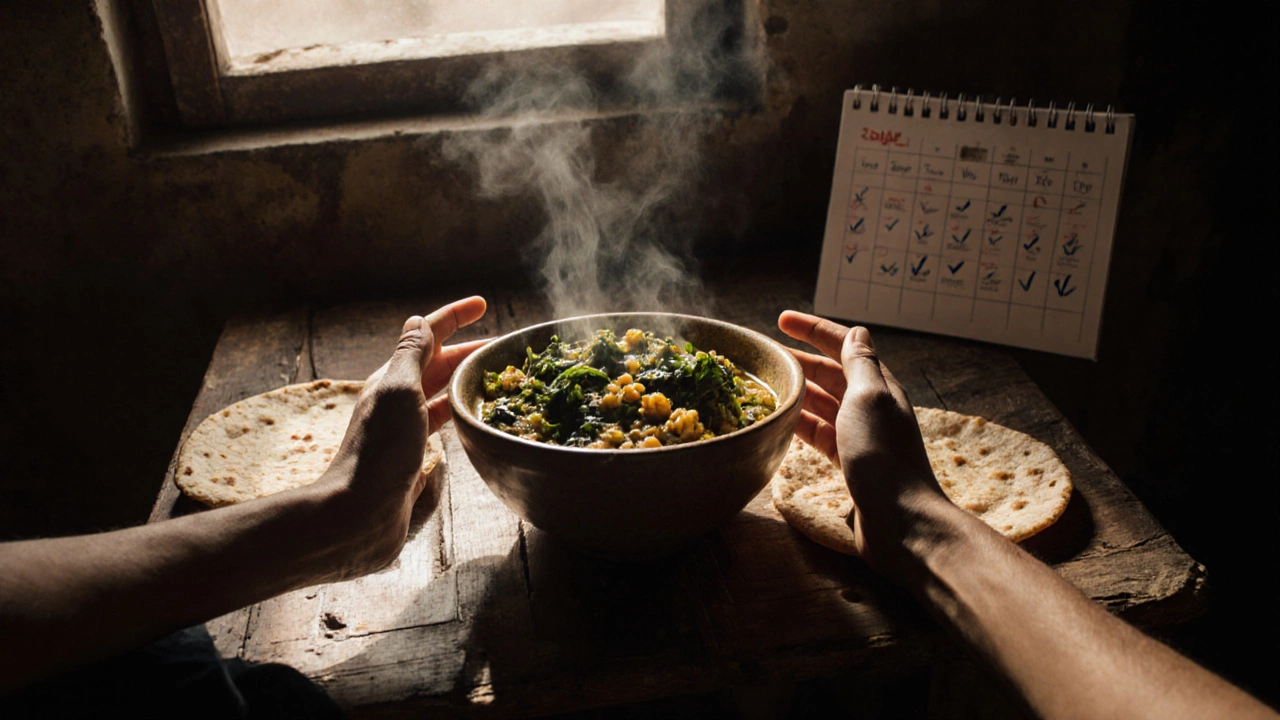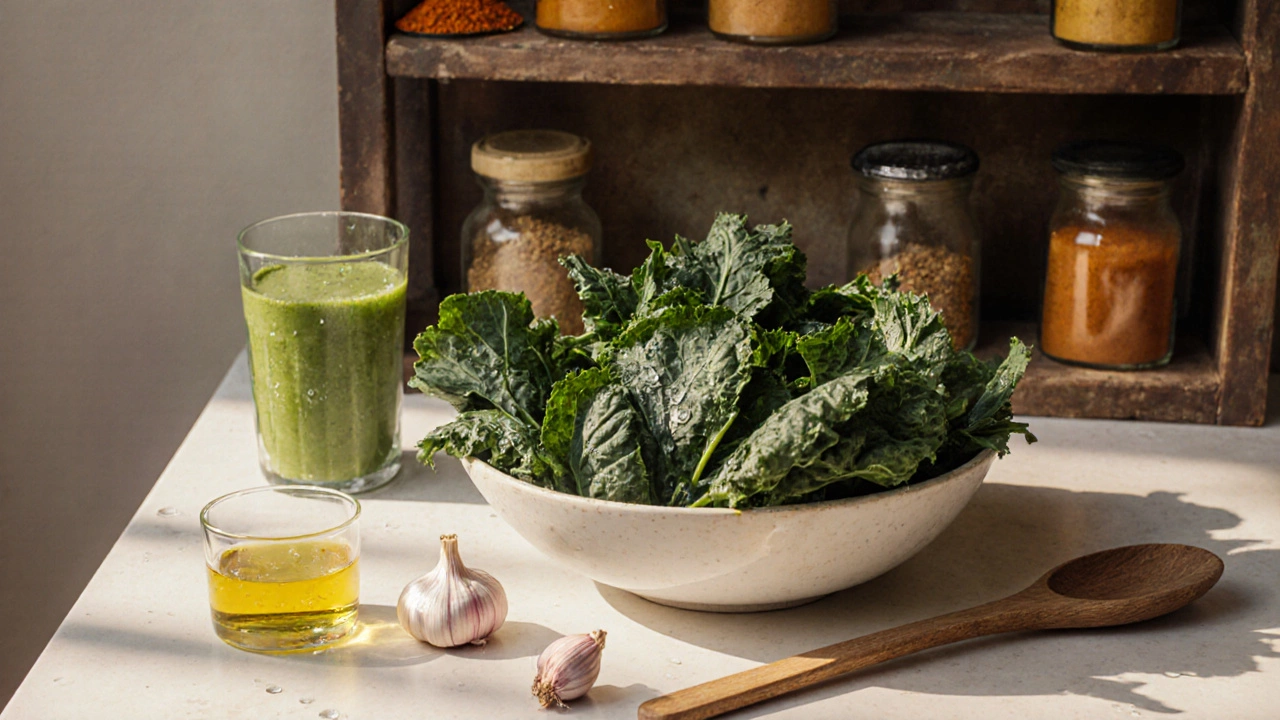Leafy Green Nutrient Calculator
Calculate Your Nutrients
There’s no single food that can fix everything. But if you had to pick one that comes closest to being the most powerful, most balanced, and most widely studied for human health, it’s leafy green vegetables-especially kale, spinach, and collard greens. Not because they’re trendy, but because of what they actually do inside your body.
Why Leafy Greens Stand Out
Most people think of superfoods like blueberries, quinoa, or chia seeds. They’re great, but they don’t match the nutrient density of dark leafy greens. A single cup of raw kale has more vitamin K than you need in a day, over 100% of your daily vitamin A, and nearly as much calcium as a glass of milk-without the saturated fat. Spinach gives you folate, iron, and lutein, which protects your eyes. Collard greens are packed with fiber and glucosinolates, compounds linked to lower cancer risk.
These aren’t just vitamins and minerals. They’re phytonutrients-plant chemicals that work like medicine. A 2022 study from the Harvard T.H. Chan School of Public Health tracked over 120,000 adults for 30 years. Those who ate at least one serving of leafy greens daily had a 15% lower risk of heart disease and a 20% lower risk of type 2 diabetes compared to those who ate less than one serving per week.
How They Work in Your Body
Leafy greens don’t just add nutrients-they clean up damage. The nitrates in spinach and kale turn into nitric oxide in your body, which helps relax blood vessels and lower blood pressure. The fiber slows digestion, keeping blood sugar steady. That’s why people who eat greens regularly don’t get the sugar crashes that lead to cravings.
They also feed your gut bacteria. Your microbiome thrives on the insoluble fiber in greens. A healthy gut means better immunity, less inflammation, and even improved mood. A 2023 study in *Nature Food* showed that people who ate five or more servings of leafy greens weekly had a different gut microbiome profile than those who didn’t-specifically, more of the bacteria linked to reduced inflammation.

What About Other Superfoods?
Blueberries have antioxidants. Salmon has omega-3s. Nuts have healthy fats. All good. But none of them offer the full package. Blueberries don’t give you vitamin K or calcium. Salmon lacks fiber. Nuts are calorie-dense and can trigger overeating if you’re not careful.
Leafy greens are low in calories, high in volume, and fill you up without adding weight. You can eat two big bowls of spinach and still be under 100 calories. Try that with nuts or avocado. You’d be at 500+ calories before you knew it.
Real-Life Impact
In rural parts of India, where people eat a lot of spinach, methi, and bathua with their dal and roti, rates of metabolic syndrome are significantly lower than in urban areas where processed foods dominate. A 2024 study in the *Indian Journal of Public Health* found that villagers who ate leafy greens daily had 40% lower rates of high blood pressure and 35% lower fasting glucose levels than city dwellers with similar activity levels.
It’s not magic. It’s consistency. One serving a day, every day. Not just when you’re on a cleanse or trying to lose weight. Just part of your routine.

How to Eat More Without Getting Bored
You don’t need to eat raw salads every day. Here’s how real people do it:
- Blend spinach into smoothies-half a cup hides easily with banana and peanut butter.
- Sauté kale with garlic and olive oil as a side dish. It’s quicker than microwaving frozen veggies.
- Add chopped collards to soups and stews. They hold up well and add depth.
- Use large lettuce or cabbage leaves as wraps instead of bread.
- Make a weekly “green batch”-steam a big pot of kale and spinach, then mix it into omelets, rice bowls, or pasta sauce.
Start small. Add one extra serving a day. Notice how your energy changes after a week. That’s not placebo. That’s your body responding to real nutrients.
The Bottom Line
There’s no magic bullet. But if you want one food to anchor your diet, make it leafy greens. They’re cheap, available year-round, and work for everyone-whether you’re 20 or 70, diabetic or healthy, vegetarian or meat-eater.
They don’t promise miracles. But they do deliver steady, long-term results: better blood pressure, stable energy, clearer skin, and lower disease risk. That’s not hype. That’s science.
Stop looking for the next miracle superfood. Just eat your greens. Every day. That’s the real secret.
Is kale really the healthiest leafy green?
Kale is very nutrient-dense, but it’s not the only one. Spinach has more iron and folate, collard greens have more calcium, and Swiss chard has higher levels of antioxidants. The best approach is variety. Rotate your greens weekly so you get a wider range of nutrients.
Can I get all my nutrients from leafy greens alone?
No. Leafy greens are powerful, but they don’t provide enough protein, vitamin B12, or omega-3 fatty acids. You still need legumes, eggs, fish, nuts, or fortified foods to cover those. Think of greens as the foundation, not the whole house.
Are frozen leafy greens as healthy as fresh ones?
Yes. Frozen greens are usually flash-frozen right after harvest, locking in nutrients. In fact, they often have more vitamins than fresh greens that’ve been sitting in a store for days. Choose plain frozen without sauces or salt.
Do leafy greens interfere with thyroid function?
Some leafy greens like kale and spinach contain goitrogens, which can affect thyroid function in large amounts-especially if you have an existing iodine deficiency. Cooking them reduces this effect. For most people, eating normal portions is perfectly safe. If you have hypothyroidism, talk to your doctor about balancing your intake.
How much should I eat daily?
Aim for at least one cup of raw greens or half a cup cooked per day. That’s about two handfuls. Studies show benefits start at this level and increase with more, but even one serving makes a measurable difference over time.





